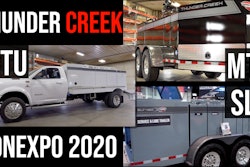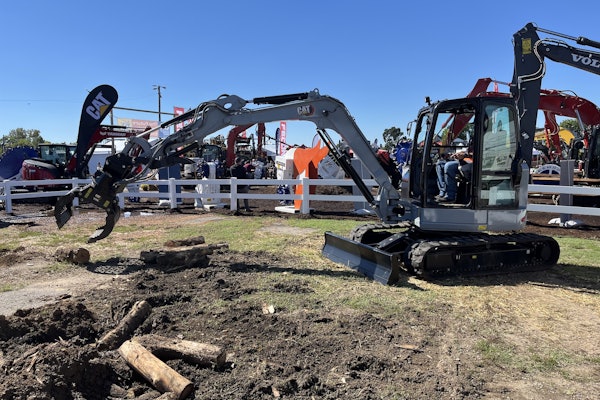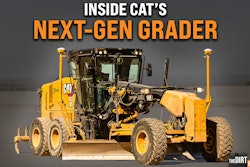It’s always a good idea to follow best practices in any maintenance program. But what about avoiding worst practices when it comes to fluid management? Here are some of the things you should work to eliminate from your shop’s maintenance routines.
Improper oil storage

Big construction fleets often have their oil delivered in drums or bulk containers. If those sit out in the elements, heating up and cooling down and getting rained on, moisture in the form of humidity can get sucked past the gaskets on the bungs. Water in your oil means water in your engine and corrosion and loss of lubricity. A simple solution for this is to store them under a roof and use desiccant breathers.
Moving from bulk storage to the machine also introduces opportunities for contamination. Sometimes technicians will use a spare container that had been used to handle other products such as coolant, transmission or hydraulic fluid. Even small amounts of these other fluids will compromise the effectiveness of your lube oil and cause error readings in an oil analysis report.
Operators should understand that running a machine hot can shorten the life of the engine or ruin the oil as well. As engine temperature increases, the oxidative life of the oil decreases. Lube oil oxidation today is a big deal in the heavy equipment world and today’s engines are running hotter than engines from just a few years ago. This is one of the reasons the oil industry developed a new lube oil standard, API CK-4, which requires heavy-duty diesel engine oils to better resist oxidative degradation.
Reacting to red flags
When you get your used oil analysis, take time to study the results, don’t just scan for red flags and then put them in a drawer. When fleet managers see a red flag on an oil analysis report, they have to pull the machine from the field and find out what’s going on. This is reactive maintenance, rather than proactive. In many cases by the time you see a red flag, there’s probably already some damage to the engine.
Oil analysis is all about trend lines. When you get a sample that shows something wrong, you probably had a previous sample that gave you a hint. Getting ahead of the problem like this enables you to schedule maintenance before it becomes an emergency and then disrupts operations.
Confusion about coolants
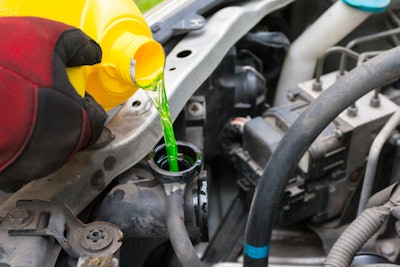
The problem arises when someone tops off a radiator with the wrong fluid. Maybe the maintenance manager uses the right coolant. But does the operator know this or the field service technician, a contracted service provider, a driver or whoever first notices the low coolant level?
In mixing two types of coolants, you are setting yourself up for possible catastrophic corrosion. This corrosion can eat a hole from the coolant side of a cylinder liner to the oil side. And by the time you see coolant show up in your oil samples, it’s too late. Major damage has been done.
The solution is to make sure everybody – mechanics, operators, drivers, contract maintenance people – understands the brand and type of coolant used and the dangers of mixing two formulas. This requires training and perhaps an operator care program so that somebody topping up in the field doesn’t accidently put in the wrong coolant.
The second line of defense is to monitor coolants with test strips made for your coolant type. Wet these simple paper strips with coolant in the system. If they turn one color, you’re good to go. A different color means your coolant doesn’t have a high enough percentage of the right additives to prevent corrosion.
Another recommended step is to check the freeze point of the coolant with a hygrometer, or for more accurate results, a refractometer. This will tell you if your coolant is too diluted with water, which also reduces its anti-corrosion properties.
If the coolant is out of spec, it’s not usually necessary to drain and refill the entire system, which on some machines can require dozens of gallons. Coolant vendors offer concentrated coolants to allow customers to bring the coolant levels to the recommended freeze points. A freeze point correction chart will show you how to adjust your coolant so that it is at the proper level. Correction fluids are used to restore additive content to recommended levels. These two procedures enable you to bring your equipment’s coolant back into spec without draining the cooling system.
Your coolant vendor can help you establish these procedures. A good practice is to test the coolant every time you change the oil.
Ignoring grease intervals
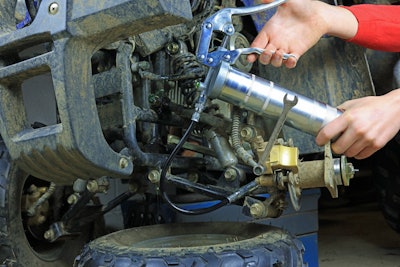
When you pump a lot of grease through a joint, most of it is wasted. The amount of grease that is doing the lubrication is actually very small. The mechanical motion of the joint tends to squeeze that grease out over time. Until it gets re-greased, it’s going to have no lubricant in the joint. So overextending grease intervals is not a good idea. This is why central grease systems work so well. They give a tiny bit of grease frequently. Grease can also get contaminated. By greasing more frequently, you purge the contaminated grease.
Moly greases, those that contain a small amount of molybdenum, are better at sticking in a joint. But you should find the OEM’s specifications for all greasing applications and stick to them. For example, a heavy-duty grease with tackifiers works better on joints under a heavy load. But those greases aren’t good for things like lubricating U-joints on drive shafts, with their small needle bearings and passageways.




